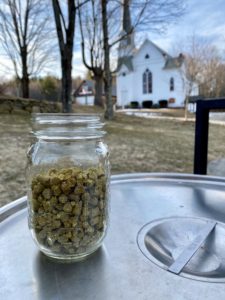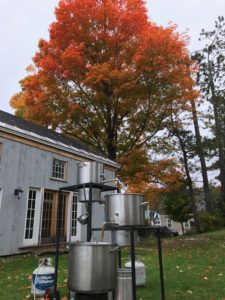Budweiser ruined it and the craft movement overlooked it. In this post we bring it back to the basics and show you some practical techniques to help you brew a traditional pilsner.
It really comes down to two things: high quality ingredients and brewing process. While other beer styles are largely focused on arranging a more complex selection of grains and hops to achieve a unique flavor, the pilsner strives for refinement through simplicity. Simplicity does not mean boring though!
This post documents the way that I have been able to craft kick-ass pilsners in a home-brew setting. I have intentionally left out some of the more basic and routine steps of home-brewing and focused only on the unique parts of the pilsner brewing process. Hope you enjoy and happy brewing!
Batch Size: 10 gallons
The Ingredients
Grain Selection
- 17 lbs Weyermann Bohemian Pilsner Malt
- 5.6 oz Weyerman Aciduated Malt
- 3 oz Weyermann CaraBohemian Malt
Hops
- Saaz 3.6 AA
- Hallertau 4.6 AA
| Boil Time | Hop 1 | Hop 2 | Total HBU |
| 50 minutes | Hallertau 1.6 oz (7.5 HBU) | Saaz 2.1 oz (7.5 HBU) | 15 |
| 10 minutes | Hallertau 0.65 oz (3 HBU) | Saaz 0.85 oz (3 HBU) | 6 |
| 2 minutes | Hallertau 0.2 oz (1 HBU) | Saaz 0.3 oz (1 HBU) | 2 |
Yeast
I have had great results with all of the following yeasts although my current favorite is the Saflager dry yeast due to its particularly clean malty finish. The yeast is also a breeze to use because no yeast starter is required. Just follow the instructions for dehydrating your yeast, pour into your wort and call it a day!
- Wyeast 2124 Bohemian Lager
- White Labs WLP830
- Saflager W-34/70 Lager Dry Yeast
The Process
Mash and Decoction
- Begin the mash at 148 degrees Fahrenheit and hold this temperature for 45 minutes. Around the 30 minute mark you will begin to notice that the top layer of liquid in your mash tun has turned from hazy to clear. This is confirmation that your malt starches have been converted to sugars and you are ready to go to step 2!
- This next step is called a decoction and is critical for developing the final flavor of your beer. Put simply, a decoction is the process of temporary removing and boiling a portion of the grains used in the mash. The result of this boiling process is the creation of caramelized sugars. Taking an otherwise bland pilsner (due to a boring grain selection) and darkening the color and adding slight caramel notes to the final beer. Begin the decoction by removing approximately one quart of wet grain from the mash per recipe pound. I remove approximately 17 quarts for this recipe. Place these wet grains in a separate kettle and begin to heat while continuously mixing to avoid burning. Once you see the first signs of a boil set a timer for 5 minutes. Continue mixing for the entire 5 minutes.
- Stop boiling after five minutes and return the boiled grains back to the original kettle quart by quart. Have an eye on the temperature and keep adding grains until you reach 155 degrees. Slowly add the remaining grains while maintaining this temperature. After 15 minutes at 155 degrees you are ready for the sparge!
Fermentation
- Ferment at 52 degrees for 4 weeks in the same primary fermenter.
Please send us your questions or comments, we would love to hear them! Check out www.baraly.com for any equipment needed for the kegging process of your new pilsner!


